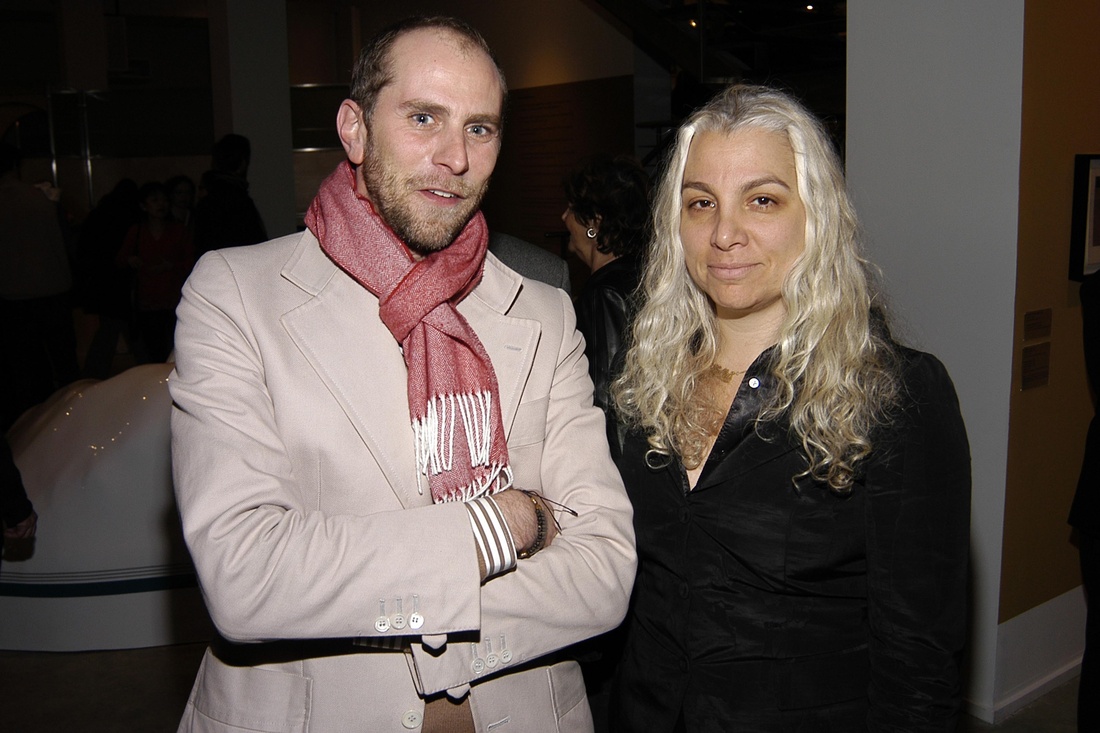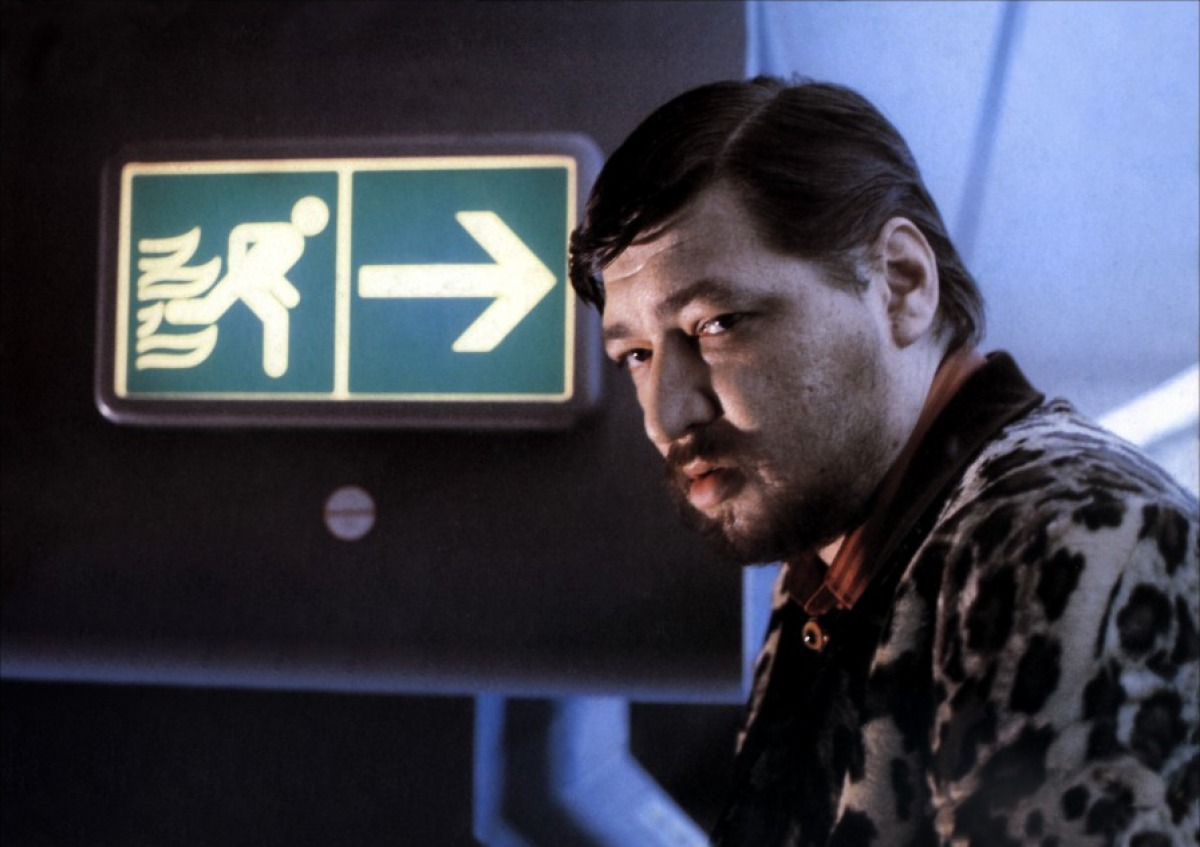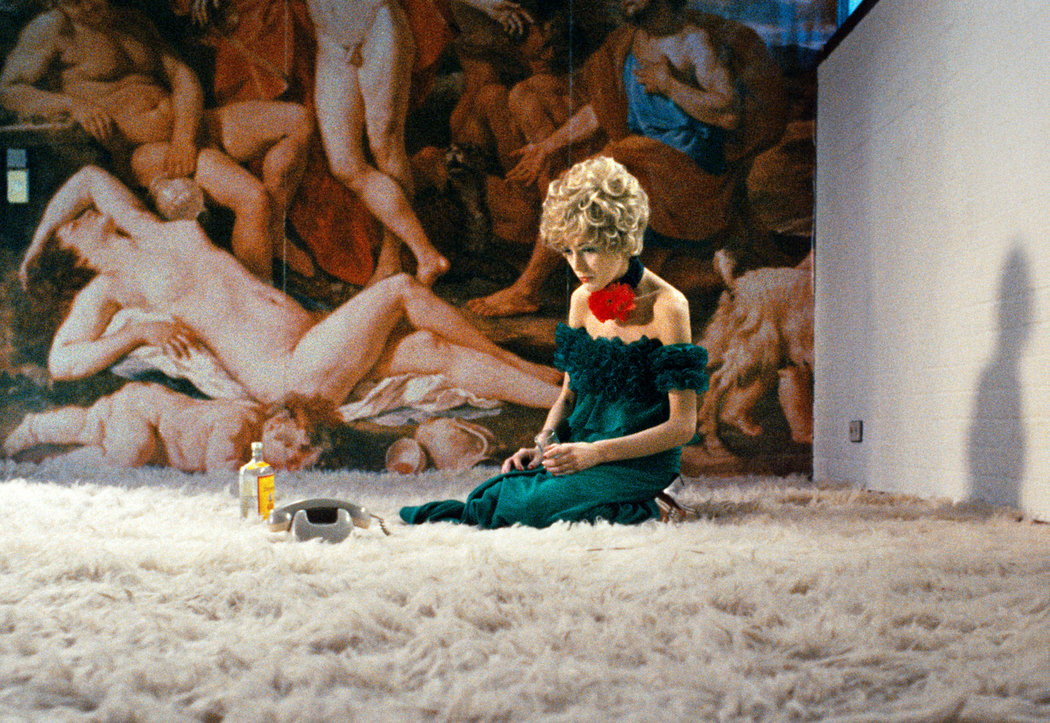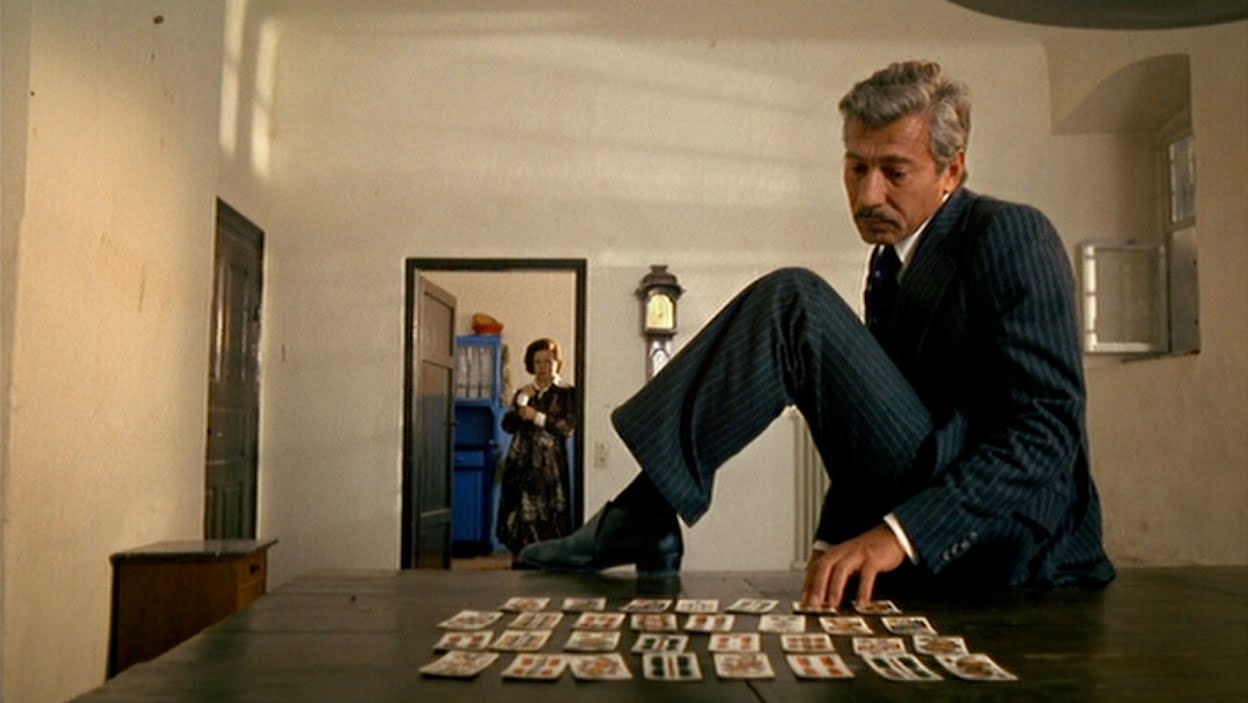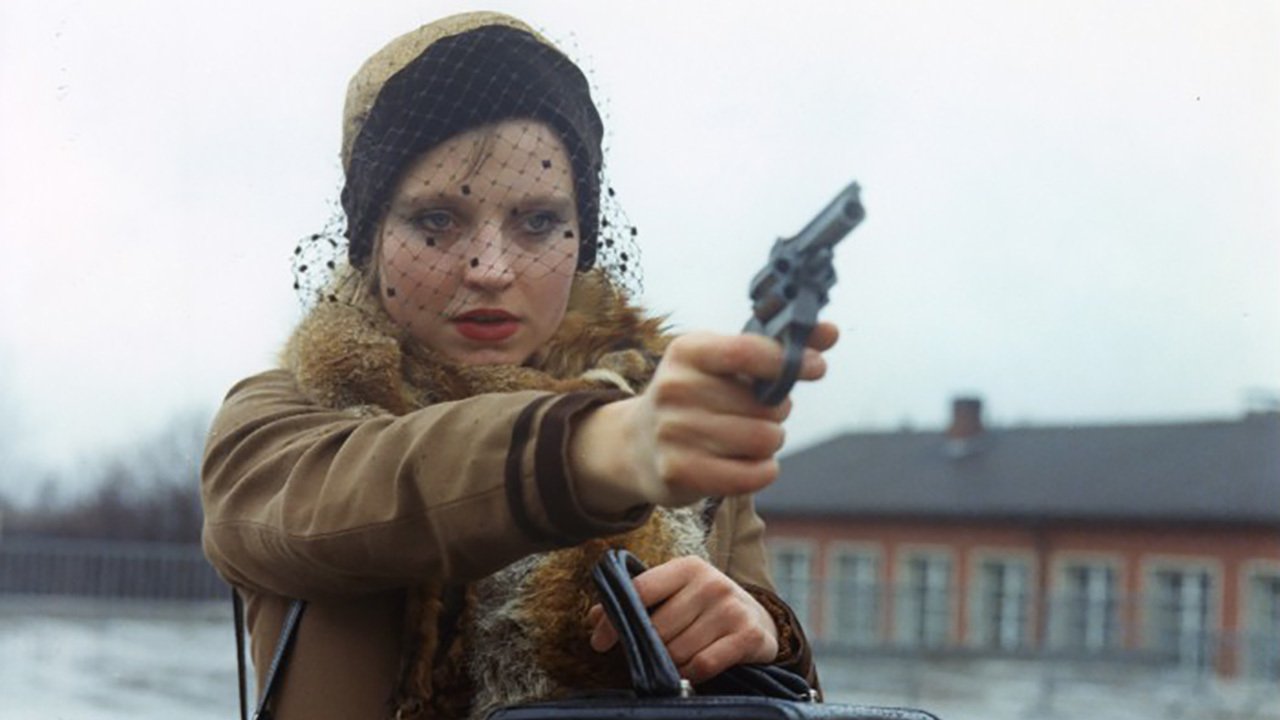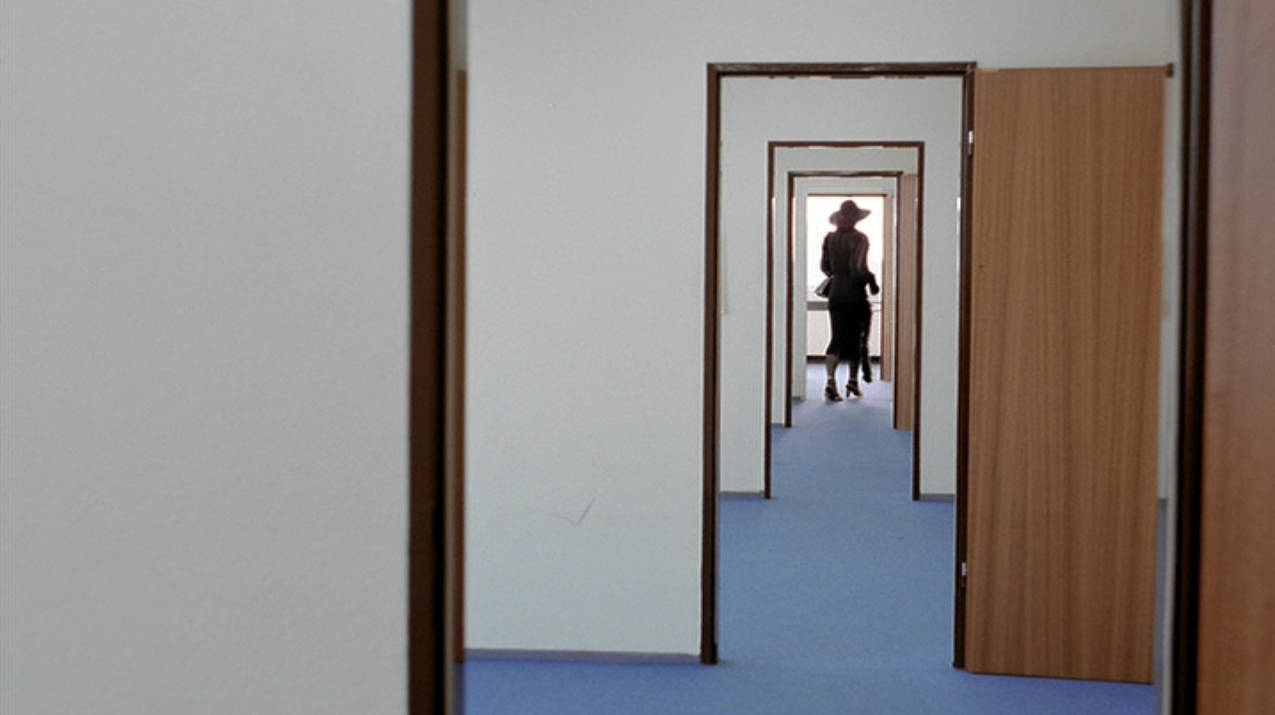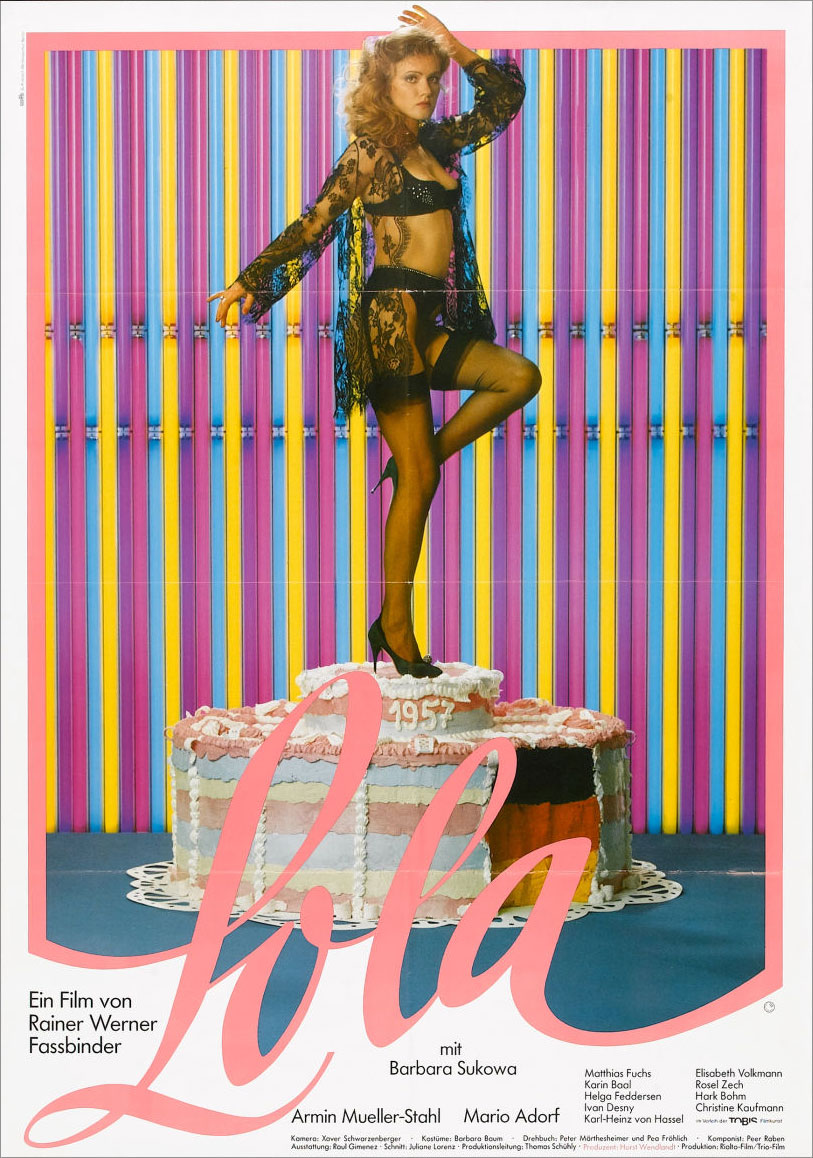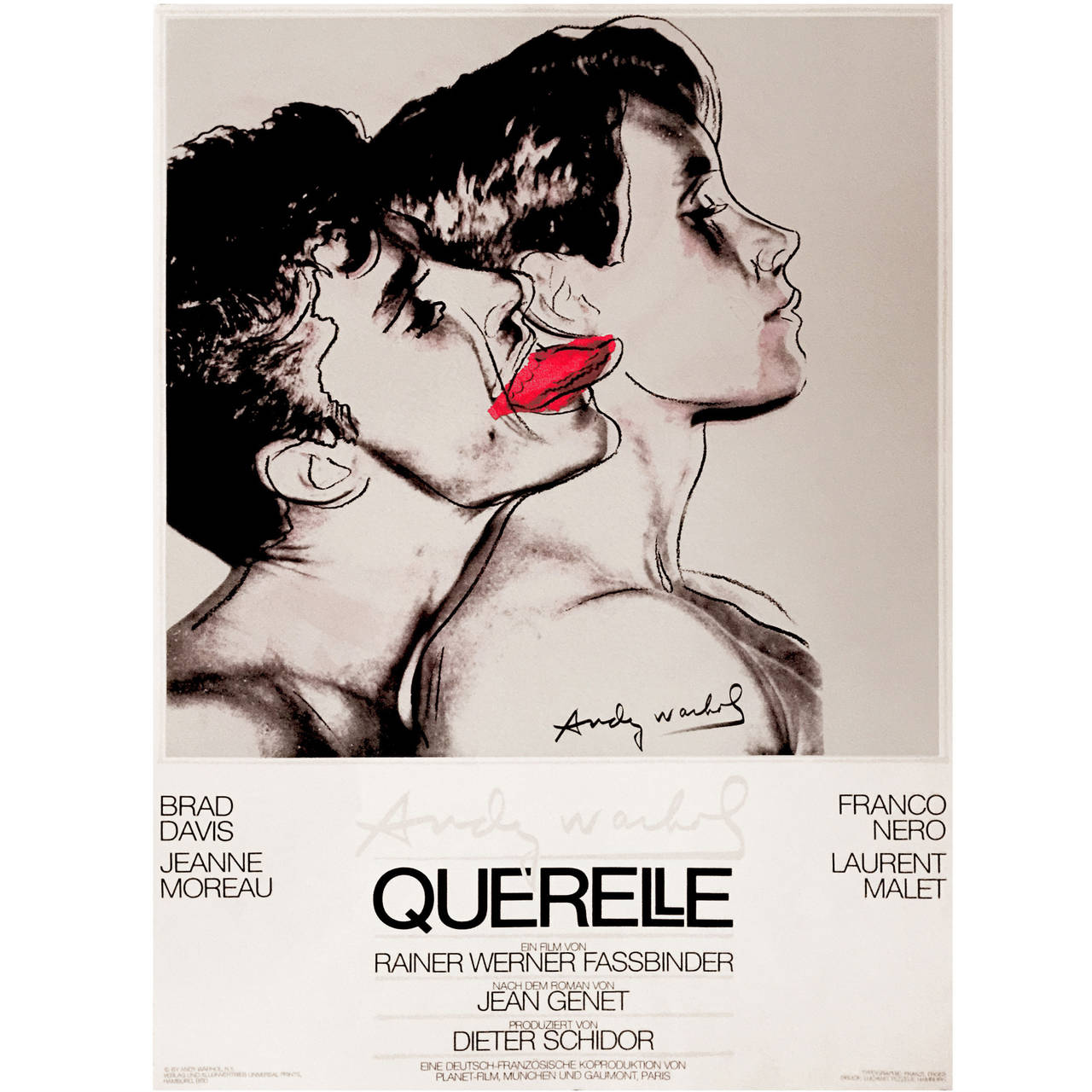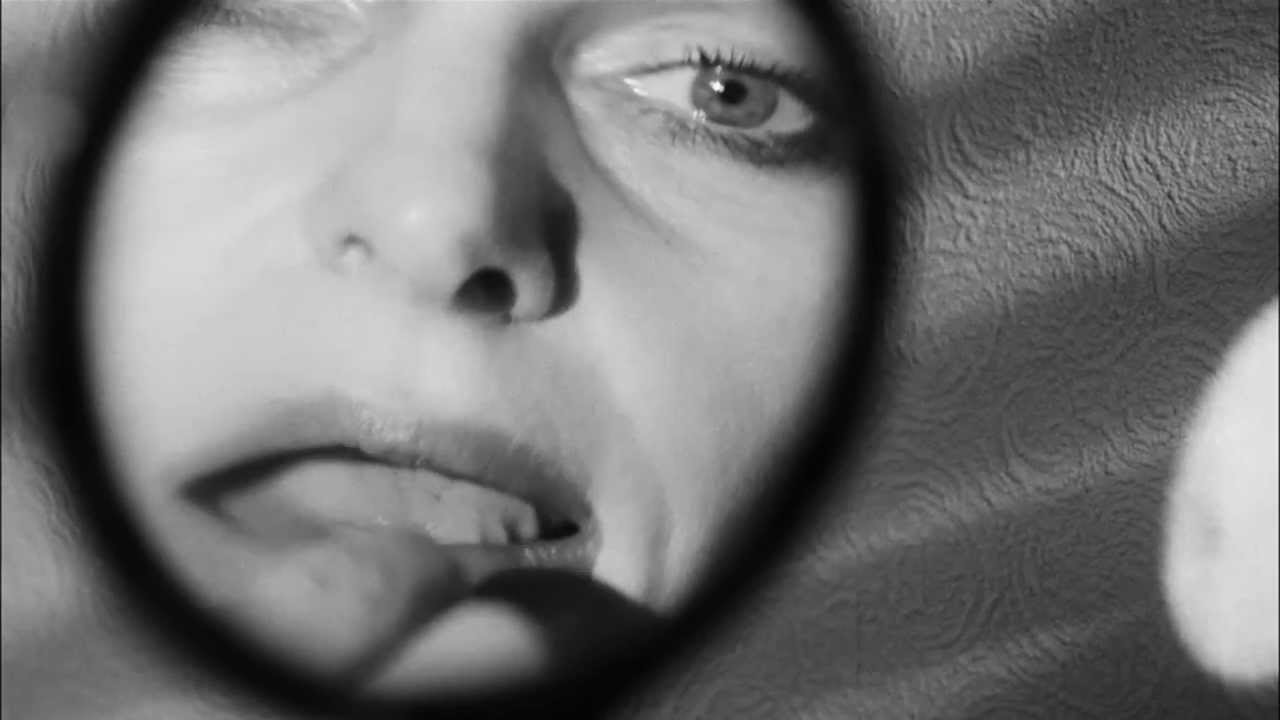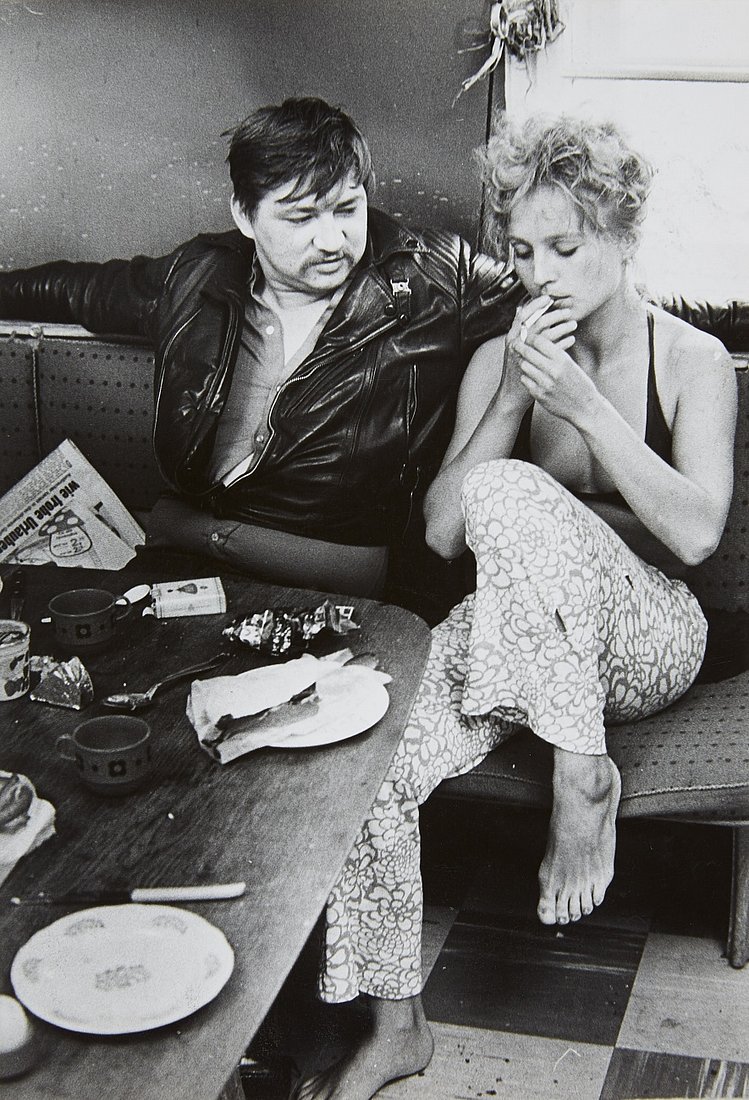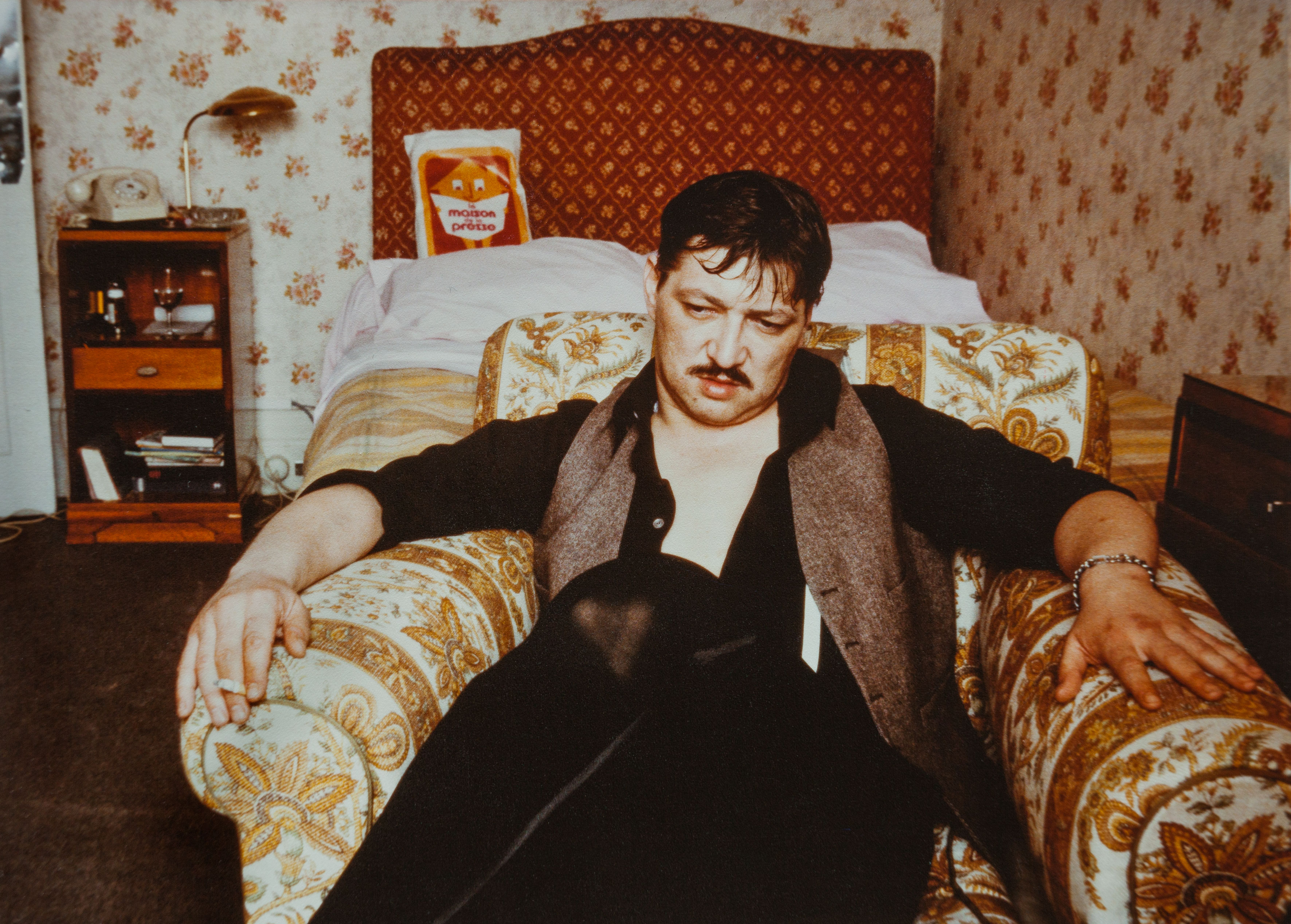The prolific, careening career of Rainer Werner Fassbinder.

RAINER WERNER FASSBINDER.
FAUST: Joy is not the issue,
I give myself to frenzy, to pleasure that hurts most. —Goethe
Death stands there with its thing sticking out. —Frederick Seidel
“Ah,” said the policeman studying the corpse on that summer morning in 1982, “even Fassbinder is mortal.” The German filmmaker lay on his bed in a swank benefactor’s penthouse, flesh cold, blood snaking from one nostril and the script for a new project—a spaced-out biopic of the communist heroine Rosa Luxemburg—lying next to his body. The postmortem would later reveal that Rainer Werner Fassbinder, aged thirty-seven, had died around four
A.M. on June 10, his heart stopped by the fatal interaction between a mixture of cocaine and sleeping pills. Even if this scene related in Robert Katz’s scurrilous biography
Love Is Colder Than Death (1987) is cultish apocrypha, there is something in its freeze-framed combination of unbelievable fact, mythic allure and disclosure of a desolate fall that serves to encapsulate Rainer Werner Fassbinder’s life. Dionysiac excess was the norm: he drank all day, snorted snowdrifts of coke like a vacuum and gorged on barbiturates by the bagful but work was all that mattered. He spent the next day behind the camera shooting his new project, editing its predecessor at night, and writing whatever was next until dawn. “I really have a drive that’s hard to explain,” he said, “I’m actually only happy when I’m doing things and that’s my drug, if you will.”
Adopt his thinking and the merits of coupling sleeping pills with cocaine are obvious: achieve white-hot exhilaration with coke but smooth that comedown into a sweet dream with a rainbow combination of knockout tranquilizers. If that wasn’t a fast enough route to oblivion, he wasn’t scared to darken the mixture with a little heroin and promptly vanish down a black hole for the next few hours. The drugs would be syncopated with whiskey sloshed into a pint glass to keep his thinking limber and remove any residual jitters from the cocaine. For any observer, the whole desperate party must have looked like a suicide accomplished in slow motion. Fassbinder had kept up this rhythm for years; his films, too, were about fatal interactions, encounters between the kind-hearted and wicked that frequently end with the innocent’s demise. The policeman was right: he didn’t seem to have the same needs or limits as other men—he was, to quote the filmmaker Werner Herzog’s fond description of his friend, “an unruly beast.”
This beastliness manifested itself in numerous ways as Fassbinder sought to violate the repressive shibboleths of his society. He was an uproarious queer hoodlum prone to acts of wild cupidity who was well-versed in Marxist arcana and called himself a “romantic anarchist.” Refusing to see any of these contrary tastes as paradoxical, he irradiated all his interviews with brash provocations (“In this society,” he wrote in response to a magazine questionnaire submitted by a band of schoolchildren, “there’s no one who isn’t mentally ill”) and made certain all his fiery carousing was public knowledge. Late in the 1970s, panicky tabloids alleged that he was often seen waving “five hundred marks at male prostitutes” during sultry nights in the city: he knew everybody could be bought, including himself.
Even his addictions were conducted with a certain leopard-print swagger, since he embarked on private-jet flights to dealers to soothe his cravings for narcotics and called on a retinue of golden boys to satisfy his lust. The latest object of his affections could expect to be lavished with expensive gifts, and he wrecked fast cars like they were children’s toys, accumulating enough to start his own junkyard in the process. “Rainer thought that was cool,” his old accomplice Harry Baer remembered, “the more wrecks the better.” Playing the lead role in
Fox and His Friends (1975), a gay carnival worker who’s won the lottery and suffered nothing but unhappiness since, Fassbinder attempts to sell his futuristic folly of a sports car. The dealer on the lot proves he’s scrupulous by cracking the joke, “What am I, a Jew?” Fassbinder was committed to saying the unspeakable and, in his own mordant fashion, to critiquing the illusory solace purveyed by all kinds of institutions from marriage to doctrinaire communism. Snickering wickedly during a TV interview, he roused the ugliest specters of German history by announcing that many people still “require a Führer.”

FROM THE BITTER TEARS OF PETRA VON KANT.
Such a commitment to acidic candor meant Fassbinder angered many in authority, including right-on gay activists who wished their clan to appear on film as hygienic saints, sapphic dames who called his depiction of lesbian abjection in
The Bitter Tears of Petra von Kant (1972) misogynistic, or the hare-brained anarchists who scorned him as a traitor for making their movement into the subject of ferocious comedy for
Mother Küsters’ Trip to Heaven (1975). His trademark look—scowl, cigarette, goatish beard and slouch hat—assured he was readymade for tabloid caricature.
Weigh all that against the expansiveness of his
oeuvre: forty films in eighteen years, so acute and wide-ranging in their account of German society they could be classified as a cinematic territory all their own—the critic Ian Penman called it the “Fassbinderrepublik.” Or return to these productions knowing certain outrageous facts: his episode for the film
Germany in Autumn (1978), a bleak collective reckoning with the aftermath of the Red Army Faction’s attacks and the suicides of its ringleaders, went from conception to completion in ten days. Given this manic productivity, there might be an attendant assumption that more than a few of the films are fuzzy-headed experiments or sly conceptual jests in the style of those early movies from Warhol’s Factory, but all are masterful productions, moving at a stately pace and totally inimitable in their mixture of artifice, raw cruelty, and chill dispassion. He had a system nobody else possessed and taxed it to its limits. “There’s this strange compulsion to work which is certainly a strength and a weakness,” as he admitted in an interview two months before his death, “I’d say I’m a manic depressive and I just try to be depressive as seldom as possible.” His mother adduced a different kind of desperate energy at work: “Rainer,” she said, “simply didn’t count on growing old.”
But probe beyond the misanthropic end of legend and a far more bewildering figure appears. Despite his ruinous intake of drugs and booze, Fassbinder always maintained an equally fearsome lucidity. There were no signs of a drooling id let loose or canny subterfuge between his public image and private life: this was simply how he lived, none of the illicit joys or furies hidden, in a drama to rival any of his films. In the delirious epilogue to his masterpiece
Berlin Alexanderplatz (1980), Fassbinder stands in the company of two golden-winged angels watching the hero Franz Biberkopf crawl, mad, through an abattoir. (Angels are a leitmotif in the later films: their appearance is rarely a happy sign; abattoirs became his favorite metaphor for German society.) One of the angels murmurs to her accomplices, “Death sings a slow song,” and Fassbinder never pretended he wasn’t intoxicated by its sound.
Premonitions of death are everywhere in his films, waiting to be tallied up and hinting that their maker knows the circumstances of his own demise: the ruined hero in
The Merchant of Four Seasons (1972) downs shots of brandy at the kitchen table until he slumps over, wrecked, his heart stopped; Elvira the transgender heroine from
In a Year of 13 Moons (1978) overdoses on prescription pills in her bedroom. Fassbinder was thrilled by Robert Bresson’s
The Devil, Probably (1977), a savage little parable about a teenage boy’s journey toward suicide which exhibits the same brand of eerie fatalism found in many of his films. But the counterpoint to the unshakeable belief that existence was nothing more than some unholy Totentanz was this equal need to lead a truly incandescent life, one where he would never have to slow down or discipline some of his more dangerous impulses.

FROM CHINESE ROULETTE
Fassbinder was born in May 1945 as Germany lay in ruins. Rebellion was a necessity for many children born after the fall of the Third Reich who could not make peace with those seduced or acquiescent to the demands of fascism. In adulthood, he claimed that his mother and father were out-of-focus figures at the edge of his early life, which was at once the truth and a potent symbolic statement. As Irm Hermann, one of the actresses who took the ice queen role in his films, averred in the documentary on Fassbinder,
I Don’t Just Want You to Love Me (1992), “We all had trouble with the eyes examining us when we were children, we couldn’t trust them.” To love anyone who had gone through the horrors of the recent past might feel scary, difficult, or like some other form of sinister collaboration, considering what they’d seen, or claimed not to see. Growing up, there’s evidence of catastrophe everywhere but an ominous silence prevails whenever questions are asked about its cause. Such an atmosphere of smothered dread and secrecy could only be broken by defiance. Fassbinder’s air for misbehavior combined with that compulsive need to expose the turmoil that others deemed too troublesome to contemplate was a means of retaliation. “I see things burning,” he told a producer in the 1970s, “things going wrong,” and they needed to be chronicled. Symbolic, real or spectral, all fathers had to be overthrown. Certain of his contemporaries would choose more violent methods to deal with these toxic feelings that vexed relations between parents and children. Both Andreas Baader and Ulrike Meinhof were known to Fassbinder as their world occasionally overlapped with that of his “anti-theatre” gang in the 1960s. In reckoning with the traumas of postwar Germany, he dedicated himself to a more subversive mode of cultural terrorism than they did.
His mother remembered that his talent for trashing the establishment and deducing exploitation manifested early on, frequently telling the tale of how he wandered into a church, aged six, and announced to the congregation, “You say this is God’s house but I can’t see him anywhere.” His father (gone by the time young Rainer hit what he later called his “murderous puberty”) was a doctor who kept his practice at home and took street denizens as patients. Way before he could be truly conscious of such matters, Fassbinder had some formative awareness that society was a big rowdy pageant involving all kinds of people, each with their own fears and proclivities. There’s a touch of the physician’s coldhearted acuity in the way he dissects the impulses of his characters. His mother translated Truman Capote and Patricia Highsmith, two sharp-eyed investigators of human cruelty and folly, in between spending long spells at a sanatorium recuperating from a lung complaint. Throughout this childhood and adolescence where the notion of family was hazy at best, trips to the cinema offered him a remedy, a substitute world of color, music and fantastic spectacle. Fassbinder never lost his taste for pure escapist movies or respect for their power over audiences: he was the one who saw Douglas Sirk’s movies for the lacerating critiques of American society they really were, praising them in a 1971 essay back when they were regarded as just swoony melodramas. In the dark, something happened—he saw how his caustic intelligence and equal desire to be ravished by the cinema could be brought together to give him a purpose.
More curious habits were surfacing, too. By his mid-teens, he was an industrious pimp, though the only prostitute working for him was an adolescent Udo Kier, the actor who went on to lend his louche matinee idol qualities to other auteurs such as Gus Van Sant or Lars Von Trier and show up amid the festivities in Madonna’s book Sex (1992), surveying a bunch of nude hunks in Miami with his whip in hand and eyebrow arched. Arriving at experimental theatre rehearsals in Munich when he was still in his teens, Fassbinder had a uniquely loathsome personal aura—nobody wanted to be seen with him—yet within a few weeks he had the whole company under his spell. Whatever the inexplicable particulars of this breathless to-and-fro between repulsion and charm, it was occasionally coupled with disorientating changes in appearance. Gottfried John, who appears in numerous Fassbinder productions, most notably as Berlin Alexanderplatz’s scheming weasel Reinhold, claimed, “One time he would be a fat, ugly slob, the next he would be trim and sparkling as young Marlon Brando.” In the course of his adulthood he went from acne-scarred but flamboyant imp in a leather jacket and Arabian scarf (there was always a hint of Eastern exoticism about his looks) to the ogreish gentleman of legend. He was a wily young satyr who dreamed of possessing a classic Tom of Finland physique but went to flab and ruin on a diet of junk food, uppers, downers, black beer, and white rum.

FROM RIO DAS MORTES
A giddy little scene from
Rio das Mortes (1971) catches some of his irrepressible energy. A goofy ruffian dealing with life like it’s just a variegated dare, Fassbinder bounces up to Hanna Schygulla (so much the inscrutable muse of his early films) in a tropical club. “Jailhouse Rock” kicks in and they dance together, Schygulla looping round him like a hungry feline as Fassbinder pulls off some biker boy version of “The Monkey” and his face repeatedly crumples into a bashful grin. Elvis slips away—a reverb mirage—and callow Fassbinder tumbles back to the bar, legs all water: “Ciao!”
At twenty-three, he received an early caution from a doctor that there was no way even his robust constitution could support more than a few years of his excesses but he paid the claim no attention at all. Death was waiting for him, smoking a cigarette in the alley, but there was no way he would abandon the white nights, banquets and booze, chasing the eager flesh and tasting new chemicals. Without all those delights, living would have been a graveyard anyway. That was when he was starring in the lead role in a TV production of Brecht’s Baal. Shoring up his own myth even then, he plays a poet who meets his early death with a delinquent grin. Harry Baer recalls making a Roadrunner-velocity joyride with Fassbinder through the North African desert: “Scenery? What scenery?” he joked. Hurrah, We’re Still Alive was the title of a long-planned but never completed project.
Racing along at that speed there could no moments of peacetime repose. Any idle lacuna had the attendant risk of bringing in unexpected thunderclouds: rage, depression, inertia. Like many compulsives, Fassbinder feared that if he questioned or tested its workings, his own magic formula would no longer favor him. If he stopped, maybe he wouldn’t be able to regain the old energy on his return. That turns out to be a reasonable fear if you examine the fragility of the conditions sustaining every film: heaps of cash need to be inveigled out of investors, furious debtors need to be escaped and requisite taxes dodged. And he could be genuinely tyrannical, sometimes in the style of a fairy tale villain. According to the actor Volker Spengler, at some point during the making of
Chinese Roulette (1976), he locked his actors inside the castle where they were shooting in order to encourage more agitated performances.
Though Fassbinder famously enjoyed subjecting his actors to exquisite manipulations—would he cast you in the next lm or condemn you to a winter in obscurity? At dinner would he disclose an end-of-the-night secret you once told him to the whole table?—crucial to his powers of enthrallment was a near-demonic personal charm, as exhilarating for its recipient as a hit of military amphetamine. “The relentless frenzy was only possible,” according to Baer, “because this superman was at the helm, telling everybody how beautiful everything was … [The crew] certainly would have quit if this maniac, who thought of nothing but work, hadn’t made it so much fun.” As the sky blushed at sundown, there he was with all the new hooch and cognac, the galaxies of little white pills and stardust powders spilling from his pockets, ready to throw Roxy Music on the jukebox. Who wouldn’t be smitten by those bad-boy antics or ignore, until their body shuddered in protest, the risks accompanying his embrace? “We were drunk all the time,” Baer swore, “breaking windows and stuff when we were stoned.” But in the midst of this carnival, there was always the phantom threat of black depression or hypomanic collapse: “I get so sad that I just don’t know what my life is all about,” he told a journalist, “sometimes I’m sitting around with people who don’t particularly turn me on. Then I entertain the whole table, simply because I enjoy telling stories. Then I get happy without knowing why.”
As he tells all his stories, Fassbinder demonstrates a chameleonic ability to change his style from film to film, as if he was playing with the whole scope and inventive potential of cinema as smoothly as a prestidigitator. He makes a white-hot piece of contemporary social realism (
Ali: Fear Eats the Soul, 1974), an enchanted costume drama (
Effi Briest, 1974), a sci-fi TV series (
World on a Wire, 1973), a black comedy for perverts (
Satan’s Brew, 1976) and bows out with a druggy gay fantasia (
Querelle, 1982). Perverting the ways and rules of cinematic genres is also a queer tradition. Consider the subversive remodeling of the high school musical that is John Waters’s
Hairspray (1988). Andy Warhol not only unsettled the concept of what a “film” was (sometimes, as in
Empire, 1964, his movies don’t move) but went on to suck the blood from various horror franchises, producing gory marvels like
Blood for Dracula (1975)—Udo Kier played the Count. (Acolytes at the Factory also gave Warhol the nickname “Drella,” stitching together Cinderella and Dracula to create a new mutant creature. The alias referenced his rags-to-riches transformation from poor kid out of Pittsburgh to prince of New York while simultaneously noting his undead affect and the fact that many in his orbit were left wrecked, if not dead.)

FROM IN A YEAR OF 13 MOONS
Queering the straight world is a form of revenge that proves that homosexuals can have their wicked way with modes that so often ignore their existence—Dracula comes back from the dead as a faggot!—and at the same time, all the gooey sentiments of straight life are revealed to be ridiculous. But Fassbinder’s motivations were more elaborate: he never wanted to entertain a hip subcultural crowd but forcefully occupy the consciousness of a mass audience and get right into their living room. Like a double agent, he played the formal tics of a chosen genre against his story.
Fear Eats the Soul is a flawlessly orchestrated melodrama that turns its attention simultaneously to the then-untouchable subjects of interracial and intergenerational romance. (These taboo desires are also metaphors for homosexual love.) He dwelled on the powers of the Third Reich’s military-entertainment complex by creating
Lili Marleen (1981), a production as fabulous as anything from 1940s MGM. None of his historical films were intended to be immaculate period pieces but rather what he called “interpretations” of the past created to illuminate the present. Which meant, in the case of
Lili Marleen, that fascism was alive and well in West Germany.
But In a Year of 13 Moons is unique, belonging to no genre at all. Conjured up from the deepest phase of grief as Fassbinder was mourning the suicide of his lover Armin Meier, this lm chronicles the last days in the life of Elvira, a transgender woman played by Volker Spengler. Fassbinder kicks off his odyssey at dawn on a cruising spot with a hot tongue lubriciously exploring the hollows of a male body. The goose-pimple eroticism of the moment is wrecked once Elvira’s feminine identity is disclosed. There will be a trip to a video arcade where Fassbinder trances out watching a pixelated car repeatedly crash, slyly communicating that his heroine is destined for self-destruction; there will be a visit to the convent where orphan Elvira (then Erwin) was schooled. Mother Fassbinder appears as a nun, calmly relating how her charge went from a “good boy” to a rotten creature after he was rejected by a couple meant to adopt him. There will be the usual bursts of nasty laughter, a dream about a cemetery, a fairy tale in which a girl chews o her brother’s foot and a horrific trip to the slaughterhouse. Through all this wandering, Fassbinder provides the biography of his degraded heroine, cataloguing a lifetime’s traumas, mistakes and bad faith.
At the slaughterhouse, we watch the systematic killing of livestock. A tracking shot follows cattle edging along in procession until, one by one, they are stunned, eviscerated, bled dry and skinned. On the soundtrack, Elvira moves from recalling the happiness she found working here (Armin was a butcher) to reciting a monologue from Goethe’s tragedy Torquato Tasso (c. 1786-90) in a performance that crosses a threshold from grief-stricken aria into genuine derangement: “With laurel they have crowned me, to lead me to an altar like a sacrificial beast!” Words writhe, turning into shrieks, mad barks and howls as she grows increasingly maniacal: the body is a straitjacket that must be escaped. Carcasses are strung from the ceiling, hot with gore, just like in the dark interiors of Francis Bacon’s paintings, hides tough as sackcloth are torn from bodies to reveal the marbled flesh beneath: “On this final day,” she screams, “they lured from me my poem which was my sole possession!” So much is contained within this spectacle: a grotesque meditation on what Elvira has done to her body (she underwent surgery eager to satisfy her infatuation with another man); acknowledgement of the original meaning of “Holocaust” (a ritual orbiting around an animal sacrifice) in a film dense with references to the Shoah, including the death factory of Bergen Belsen; and a desperate expression of Fassbinder’s own grief. And what In a Year of 13 Moons presents is the carcass of Fassbinder’s own “poem,” compiled from so much detritus and torn into terrifying fragments.
As Elvira sleeps that night, Fassbinder appears on her TV, being interviewed for an episode of Lebenslaufe (Life Stories) shot in 1974. “I hope,” he confesses, “so far as it is possible to change myself through my stories.” This talk about a personal need for transformation and catharsis resounds in the bedroom of his doomed heroine who has attempted to achieve both—one is a consequence of the other, natürlich—and failed. Asked what the reasons might be for the restlessness that allows him to make so many films, he jokes, “I don’t know, it must be a special kind of mental illness.” Elvira will soon be discovered in the same bedroom, dead from an overdose, a record on the turntable repeating the wild-hearted phrase, “When my dreams become reality!” The words echo as the lm fades to black, like shouts from inside a mausoleum.

Following Armin’s death, Fassbinder’s films became increasingly dreamy. This could be a self-protective response to the realities of grief but he was always more prone to staging hallucinogenic adventure than many like to admit: revisit his debut film,
Love Is Colder than Death (1969) and you can watch the young director cracking the codes of the traditional Hollywood heist flick to create a Godard-addled frolic in Expressionist black and white. But now the films would become closer to trances or drug trips, following their own sleepwalk rhythm through worlds he invented in the studio and dissolving any hint of “reality” in a range of phantasmagorical effects. In
Berlin Alexanderplatz, scenes run to the pulse of neon lights; the action is frequently glimpsed through rainy windows or occluded by layers of swirling smoke. Fassbinder induces a stupor in his audience by reading his narration in a whisper, conspiratorial, as if his mouth is at your ear in the dark: “Night is coming on,” he murmurs, “the highways frozen solid … She didn’t find the cemetery all by herself.” As the series aired on television, he confirmed this switch into reverie, telling a journalist: “When the lights go out in the movie theatre, it’s as though a dream were beginning.” But it would be dangerous to interpret this talk about flight into dream as “mere” escapism or ignore its shadowier ramifications: dreams grow out of sickness, longing or loss; they are, after all, where we are at our most isolated. He wrote that “nothing is equal to the terror of dreams come true.”
Queer filmmakers had long departed from cruel reality to explore their desires: James Bidgood transformed his tiny New York apartment into a harem for Pink Narcissus (1971), conjuring up the hot daydreams of his teenage hero with all the frisky spirit of some imaginary collaboration between Georges Méliès and a beefcake magazine enthusiast. The short films collected in Kenneth Anger’s The Magick Lantern Cycle (1947-81) create a world in which reworks explode from the crotches of lusty sailors and the Grim Reaper is a hoodlum riding a motorbike to a Motown soundtrack. Anger wrote of Lucifer’s battle with God as a war between a rascal son and strait-laced Pop: “Lucifer created his own light shows in Heaven … Eventually he was expelled for playing the stereo too loud.” A disciple of Aleister Crowley’s religion, Thelema, who produced the first installment in his Cycle when he was seventeen, Anger mixed Tinseltown glamour with occult energies to create his own cinematic witch’s brew. No insignificant feat to do some of that at a time when homosexuality was being “remedied” by a few lightning strikes of electro-shock treatment. Concerning her early thoughts about young Rainer’s homosexuality, which she discovered during his adolescence, his mother asserted, “I thought it was a disease.”
Nightclubs and drugs were also inspiring him to create his own artificial worlds. There’s no evidence of Fassbinder tripping on acid but he achieves psychedelic rapture via Technicolor, saturating every scene of
Lola (1981) with light. Running amok in New York circa summer 1978, he scores MDA (ecstasy’s unadulterated pharmaceutical forerunner) from Cookie Mueller, a member of John Waters’s Dreamlanders repertory whose vibe as an actress could be described as white-trash Edie Sedgwick. The surfaces in all his subsequent movies radiate a telltale glow. Queer nightlife was becoming a jungle all of its own. In New York, there was Le Clique, a traveling disco where actors, acrobats, and clowns performed alongside dancers simulating sex acts in order to inspire new intensities of debauched behavior among the revelers. (The trapeze hanging high in the club’s rafters unwittingly signaled the pre-AIDS mood of looming peril.) And there was also a subterranean topography of more, shall we say, “adventurous” dens gamely catalogued by Andy Warhol in 1979: “The Anvil, The Toilet, The Mindshaft [sic], the Cave, the Eagle’s Nest … where the disco workers go when they get off work uptown at four a.m.” Quipped Drella, who explored these places with his usual mixture of extraterrestrial delight and bafflement, “They’re too dirty, too gay, too sexy—for me. They don’t let girls in and I’m always with girls.”

Warhol provided the poster for Querelle’s American release, a modified Polaroid of two blonde surfer dudes in a bathhouse tryst, shirts off and one whispering naughty enticements in the other’s ear, his tongue painted devilish red. If the picture appears unrelated to the movie, just a Honcho snap to lure in the Time’s Square crowds, consider it a hint to Querelle’s meditation on twins, brotherhood and all other kinds of double trouble. When they met, reportedly in the company of Warhol’s “gymnastics teacher,” Warhol squealed, “Oh, Mr. Fassbinder, I saw Querelle, it made me hot for the whole day!” Fassbinder said little; he dedicated much of that last New York trip to tracking down a hustler known by the fantastical code name Rameses II.
By the time of Querelle’s shoot, Fassbinder was routinely charting jet flights back and forth from Munich to New York on his weekends off, greedily tasting all the carnal or chemical ecstasy on offer and just having the fucked-up time of his fast-expiring life. The later films approximate the activities in a hot discotheque with their strung-out inhabitants and spangled interiors. He coiled his two sources of pleasure together until there was no telling them apart—a snake devouring his own tail—and each drove him further into more extreme territories. But the dark anonymity offered within such clubs must have also felt like a kind of solace, too: his conventional attempts at love were shadowed by difficulty, ambivalence and death. A deliciously sadomasochistic metaphor from In a Year of 13 Moons: “When you love you are nailed to the cross.” And Oscar Wilde’s words are reverberating around his last and wooziest paradise, with Jeanne Moreau as their songbird: “Each man kills the thing he loves.”
All of which haunts Querelle but there are also ghoulish premonitions to be dealt with everywhere, epitaphs tattooed on those smoldering bodies. Fassbinder unwittingly presents a work scarred by its own innocence, providing a depiction of homosexuality totally invested in its most sinful possibilities just before the apocalyptic effects of AIDS came into focus. What films would he have made about the plague years? Querelle’s last words (and therefore Fassbinder’s farewell to his audience) are a quotation from Genet, glimpsed in the writer’s own fragile scribble and admitting, “The date of my death seems near.” Amplifying the tragedy in that gnomic line is the ambiguity circling around whose death exactly might be threatened. Parse it, if you wish, as referring strictly to Genet, or as an uncanny reverberation, announcing the loss of a vast subculture, or as Fassbinder ghostwriting his own end.

FROM VERONIKA VOSS
When the drugs became troublesome, he admitted it in his work.
Veronika Voss (1982) is the tale of an actress’s fall from 1930s glamourpuss to ruined junkie. Her greatest performance, which she will go on to reenact in waking life once her stardom wanes, sees the blonde starlet play a drug addict in thrall to her crooked nurse. Fassbinder kicks o at the cinema in media res with this make-believe opus,
Creeping Poison, dazzling on the screen, all shadows and silver light. Veronika’s self-immolating vow booms through the theatre, “I’ll give you everything that I have! Everything that I am!” The actress is in the audience: eyes shut tight, she can’t bear to see how closely her theatrical convulsions now mirror her real life.
This potent moment is full of Fassbinder’s favorite themes (the haunting power of the past, innocence lost, incinerated dreams) and it is also his most vivid confrontation with a problem that troubled him throughout his work and life: what happens when what you love most is a poison, creeping or not. In certain cases, such as Elvira from In a Year of 13 Moons, the person themselves will be toxic—doomed—from the very beginning. Whenever Fassbinder kisses Armin for Germany in Autumn, he’s like a vampire taking a bite out of a victim. Fox’s high society boyfriend schools him in the airless pleasures of the rich and eventually abandons him, destitute. In the train station at the end of the film, once the two wily schoolboys have stripped the hero’s body of all its loot with the sort of acquisitive spite familiar from silent films, two old friends will stumble on his corpse. Discovering his heart was stopped by a Valium overdose, they run away: the body is too dangerous to touch. The kids return, pulling at him like a mannequin as jaunty funfair music strikes up: you won’t believe what happened to this poor sucker!
Drugs can be practical or sensual, another means of dreaming or disappearance. They are also a commodity: Veronika tells the devious Doctor Katz, “You’ve given me much happiness.” “No,” she responds, “I’ve sold it to you.” Fassbinder’s pursuit of narcotics was so thorough that any sense of normality was eradicated and replaced with intoxication. Even a metabolism as bullish as his own couldn’t take such treatment and operate unscathed. During Germany in Autumn’s thorny reenactment of real life he broaches the notion of having a “problem” with drugs. Playing himself, Fassbinder acts like a brute. He rampages around dark rooms, variously wracked by fears nobody imagined he had (doubt and self-loathing), hopelessly addicted to cocaine and with his love for Armin in slow decay. He falls distraught into his lover’s arms. There’s nothing amorous about this embrace, a consoling bear-hug with the faintest trace of rocking to it, as if Fassbinder were a child being soothed after a nightmare. Strange to think that Fassbinder outlived the man holding him. Armin committed suicide two months after the movie was released, on Fassbinder’s birthday.
In 1980, he outlined a future project named Cocaine, at once writing a love letter to his favorite substance and forecasting the stylistic climate of Veronika Voss:
Cocaine freezes the brain, freeing one’s thoughts of anything inessential, and thereby liberating the essential, the imagination, concentration and so on. This freezing of the brain … will be expressed in the lm as follows: everything visible will appear covered with a sort of hoarfrost, glittering ice, whether in winter or summer; glasses and windows will be covered with ice flowers, and with all the interior shots in the studio, even in summertime, the actors’ breath will be visible, as is usually the case only when it’s bitter cold outside.
Fassbinder, much like Freud writing to his dear Martha, exulted in cocaine’s power to unleash “passionate pleasure and tireless work” but there’s also a moonbeam chill running through those lines: the director imagines retreating into a Snow Queen’s palace where winter never fades. Craving for everything to freeze in a fabulous tableau, including the mind itself, isn’t the healthiest wish. The drug had become Fassbinder’s muse and Veronika Voss is a coke end’s dream, all snowily sumptuous monochrome and sparkling mirrors. But another dreamed aesthetic preoccupied him, too: he repeatedly commanded his cinematographer to make the film “look like heaven!”

Querelle may occur in heaven, too (radiant bodies everywhere, all lusts ready to be explored) but captures how eerie exploring that space would be: heaven can only be inhabited by the dead. Where Fassbinder once assured every scene to his name was prickly with difficult emotions, now he wanted the actors to be lifeless, puppet-like. Fuck the melting sun that stays sky-high for the whole film, those ice flowers bloom in everyone’s veins. At a certain point, high can’t be distinguished from stupor and desire fades out until it possesses almost no pulse at all. Maybe that was what he wanted, just to quell the fire in his brain for a moment. Taking drugs had become a rational strategy for getting through everyday life, stilling the chaos around him and making all the surrounding pressures recede, if only until the stuff wore off again.
Early in the note on Cocaine, he outlines the desired trajectory of his life:
It is possible, even fairly certain, that relatively unrestrained or excessive use of cocaine over a fairly long time will shorten the user’s life, in whatever fashion. On the other hand, the cocaine user will experience this shorter lifespan significantly more intensely, more imaginatively, and will usually be spared the cruel depressions that suddenly befall the “normal person.”
Difficult to know whether he was announcing where his allegiances lay or devising a baroque rhetorical premise to explain his submission to the tractor beam of full-blown addiction. No matter what, nobody could ever accuse him of being a “normal person.”
“When I was very young,” he said, “I already knew I was supposed to make many films.” Those words explain his downfall more plainly than any tabulation of his drug intake: a belief that his fate was laid out from the beginning. He couldn’t entertain any pleasure that wasn’t also a source of ruin; everything had to be taken too far, beyond abandon or wonder, in the name of that devouring need, this “special mental illness.” He had carved out of a vantage point where every black impulse could be indulged, a fortune stacked up (cash was the only mode of payment he tolerated) and work accomplished on a scale that few other directors enjoyed, defying the rhythms of the market, his budgets colossal and his stars now plucked from Hollywood’s constellations. But all this could only measure the extent of his isolation. Everyone was waiting for the next masterpiece or expecting a sudden fall into mere adequacy; shadowy background characters chased him wherever he wandered and there was always the ghost of his absent father needing to be bested or silenced.
Half of him was still aflame with ambition and the other was, in Samuel Beckett’s desolate phrase, “burning to be gone.” Beady little reports came in that he had been seen roaming around all the ritziest bars in Paris, a slobbering parody of himself in a filthy suit. Old friends kept away, too nervous to approach him. But still he had films that he was ready to shoot and a headful of more projects waiting to be made. The real trouble was a body and mind operating at radically different rates: one destroyed by two decades of wicked misadventure, the other still dizzying in its agility. For so long, he had outmaneuvered the physical penalties that struck others but now, at last, they were coming for him.
It really was just like in
Faust: he had gone so far at such a rate but debts must always be paid. When he was asked to describe his film
The Third Generation (1979), Fassbinder likened the work to ‘fairy tales you tell your children so they’re better equipped to bear their lives as people buried alive’. He traded that fate for another, knowing the fall that awaited him all his riotous life.
Excerpted from This Young Monster by Charlie Fox, available now from Fitzcarraldo Editions.
Charlie Fox is a writer who lives in London. He was born in 1991. His work has appeared in many publications including frieze, Cabinet, Sight & Sound, ArtReview, The Wire, and The White Review.





